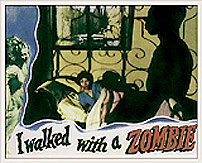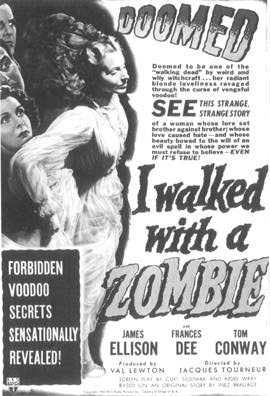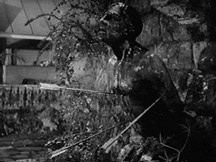|


|

|

This
melancholy tale of a nurse
and
her experience in the Caribbean is accented by cogent script
writing by Curt Siodmak, Ardel
Wray,
and Val Lewton; moody cinematography
by J. Roy Hunt, and a sensitive
music score by Roy Webb. The Direction
is by Jacques Tourneur, and the
editing by Mark Robson. The melodramatic
title is via RKO Film Executives who were trying to cash in
on the horror film boom that the Universal film studio had brought
about with their various Dracula, Frankenstein and Wolfman movies
in the 1930s-1940s. RKO had set up a special unit under Val
Lewton for the production of these films. This web site discusses
both the film I Walked with A Zombie and its producer,
Val Lewton.
About
the film
"RKO
executives really out-did themselves when they came up with
this title and told Lewton to "make a film to go with
it." But in what was to become standard procedure for
Lewton, he used the title and spooky setting as a cover
to make the story he wanted to, a re-working of Jane Eyre."
From Ken
Yousten's Val Lewton Home Page
 Val Lewton was given the title "I Walked
With A Zombie" by the RKO front office, who had drawn it
from an American Weekly article of the same name by writer
Inez Wallace. The result of that
meeting was a depressed state for Lewton. Writer Carl
Siodmak, who had written the screenplays for Frankenstein
Meets The Wolfman, Ghost of Frankenstein, and The Invisable
Woman, the novel Donovan's Brain, among others, worked
with writer Ardel Wray to flesh
out a theme based upon Haitian voodoo. Mark Robson, Zombie's
editor, recalled Lewton being depressed one day, then happily
confidant the next, announcing to his crew that they were going
to make a West Indies version of Charlotte
Bronte's Jane
Eyre. Dedicated to avoiding the formula that pervaded the
Universal horror films, and challenged by the small budgets
given him by RKO, Lewton enlisted the help of his entire crew
in shaping up an artistic film that would go beyond its B-film
origins. Val Lewton was given the title "I Walked
With A Zombie" by the RKO front office, who had drawn it
from an American Weekly article of the same name by writer
Inez Wallace. The result of that
meeting was a depressed state for Lewton. Writer Carl
Siodmak, who had written the screenplays for Frankenstein
Meets The Wolfman, Ghost of Frankenstein, and The Invisable
Woman, the novel Donovan's Brain, among others, worked
with writer Ardel Wray to flesh
out a theme based upon Haitian voodoo. Mark Robson, Zombie's
editor, recalled Lewton being depressed one day, then happily
confidant the next, announcing to his crew that they were going
to make a West Indies version of Charlotte
Bronte's Jane
Eyre. Dedicated to avoiding the formula that pervaded the
Universal horror films, and challenged by the small budgets
given him by RKO, Lewton enlisted the help of his entire crew
in shaping up an artistic film that would go beyond its B-film
origins.
 After Siodmak delivered the first version
of the script for Zombie, which, according to later interviews,
was influenced by the paintings of Oscar
Kokoschka, it was then reworked by Wray. She was a young
woman Lewton had hired from out of RKO's Young Writer's Project,
and is the only woman credited to have worked on a Lewton produced
film. The daughter of actress Virginia
Brissac and actor-director John
Griffith Wray, she had started in the RKO reading department.
After Wray, Lewton himself reworked the script a third time,
by which time Siodmak had left the production, and according
to descriptions given by Siodmak much later (he never saw the
actual finished movie) it bears considerable differences from
Siodmak's first draft. After Siodmak delivered the first version
of the script for Zombie, which, according to later interviews,
was influenced by the paintings of Oscar
Kokoschka, it was then reworked by Wray. She was a young
woman Lewton had hired from out of RKO's Young Writer's Project,
and is the only woman credited to have worked on a Lewton produced
film. The daughter of actress Virginia
Brissac and actor-director John
Griffith Wray, she had started in the RKO reading department.
After Wray, Lewton himself reworked the script a third time,
by which time Siodmak had left the production, and according
to descriptions given by Siodmak much later (he never saw the
actual finished movie) it bears considerable differences from
Siodmak's first draft.

One
of the sensationalistic RKO promo advertisements.
The
Calypso music and Haitian drum rythmns
in Zombie come from a variety of sources. C.
Bakaleinikoff was the musical director, incorporating
in particular the talents of singer/actor Sir
Lancelot, who performs "British Grenadiers"
and "Fort Holland," written in collaboration with
Lewton. According to Jacques Tourneur,
the director, Lancelot functioned as a "...Greek Chorus,
wandering in seven or eight times and explaining the plot."
Roy Webb scored the film, which
includes three Haitian folk "voodoo" songs, and a
unique counterpointing version of Chopin's "E Minor Etude,"
combined with the pulsating drums which dominate much of the
movie soundtrack.
 The central recurring image is of the old wooden figurehead
Ti Misery, which is Saint Sebastion, the island's Patron Saint,
a tragic emblem of the pain and suffering for the descendents
of the slaves that live upon the island, a figurehead that came
from Africa on a slave ship. As in Lewton's other films, the
past intrudes upon the present in baleful reminders of former
deeds which mimic present circumstance. (For example, a similar
motif of the repentant Conquistidor parade in Lewton's Leopard Man mimics the state of the film's tragic
peripheral figure, Dr. Galbraith.) In Zombie, those who
came to the island as slaves to European plantation owners are
now servants of a different kind of bondage, a bondage that
then infiltrates and controls the actions of most of the white
masters who control the island. Lewton took pains to bounce
these mirror images back and forth, underlining the sense that
the modern is built upon the foundations of the old. The central recurring image is of the old wooden figurehead
Ti Misery, which is Saint Sebastion, the island's Patron Saint,
a tragic emblem of the pain and suffering for the descendents
of the slaves that live upon the island, a figurehead that came
from Africa on a slave ship. As in Lewton's other films, the
past intrudes upon the present in baleful reminders of former
deeds which mimic present circumstance. (For example, a similar
motif of the repentant Conquistidor parade in Lewton's Leopard Man mimics the state of the film's tragic
peripheral figure, Dr. Galbraith.) In Zombie, those who
came to the island as slaves to European plantation owners are
now servants of a different kind of bondage, a bondage that
then infiltrates and controls the actions of most of the white
masters who control the island. Lewton took pains to bounce
these mirror images back and forth, underlining the sense that
the modern is built upon the foundations of the old.
The
central moment in Zombie is the "night walk"
when the nurse, Betsy, takes the "zombie wife," Jessica,
thru the fields to the Hum Fort. This "night walk"
is a repeated bridge in many of Lewton's films, and characterizes
a literary form reminescent of Joseph Conrad:
(Speaking
of Conrad's Secret Sharer and Heart of Darkness)
"The two novels alike exploit the ancient myth or archetypal
experience of the "night journey," of a provisional
descent into the primitive and unconscious sources of being."
(by Albert Guerard, from the introduction to the Signet Classic
edition.)
Betsy,
and the audience, are plunged into the escalating conflict between
what is real or fancy following this night journey. It should
also be noted that while Zombie is a "flashback"
narrated by Betsy, her last voice-over of narration comes just
before the transition of the story into a heightened dreamlike
state with the "night journey."
The
French film director of Zombie, Jacques Tourneur, later said: "a horrible title
for a very good film - the best film I've ever done in my life."
Film
Notes -
About The Story
- The Cast
Jacques Tourneur
- Val
Lewton - WWW
Links
This Site's Index
- E-Mail
Me
SITE MAP
|
 |
Filming
on I Walked With A Zombie began October 26, 1942, and
concluded November 19, 1942.
"One
day at lunch he [Val Lewton] confided he probably would be leaving
the employ of Mr. Selznick before I finished my research job
for him. Half in jest, he insinuated he was being kicked upstairs
for not having sufficiently appreciated either the novel "Gone
With the Wind" or the movie Mr. Selznick made of it. Apparently
Val had tried to persuade Mr. Selznick to forget Margaret Mitchell's
epic novel of the War between the states and film "War
and Peace" or "Vanity Fair," or both, instead.
Val delighted in pointing out similarities in the plots of those
two classics and of Gone With The Wind."
From
DeWitt Bodeen's More from Hollywood, A. S. Barnes and Co., 1977
"He
was given assignments which most contract producers would have
filmed on the back lot and shrugged off as evil necessities,
but he approached each assignment as a challenge. Forced to
submit to exploitation titles, he was determined that the pictures
hiding behind the horror titles should be films of good taste
and high production quality."
From
DeWitt Bodeen's More from Hollywood, A. S. Barnes and Co., 1977
"Given
a sensationalistic title leading viewers to expect little more
than grotesquery and standard chills, Lewton's unit could justifiably
have employed a conventional horror formula, like Universal's,
in Zombie. Simply plunging viewers inti a world threatened
by monsters and eventually releasing them from that dire grip
by vanquishing the threat would have offered audiences a comforting
and not yet trite allegory for the world struggle in which they
were involved [i.e., WW II]. Zombie's narrative mechanism,
however, pointedly works against such a pattern and the dayworld
perspective it implies in favor of a more challenging movement
into the vesperal regions of the psyche."
From
J. P. Telotte's Dreams of Darkness, University of Illinois, 1985
|